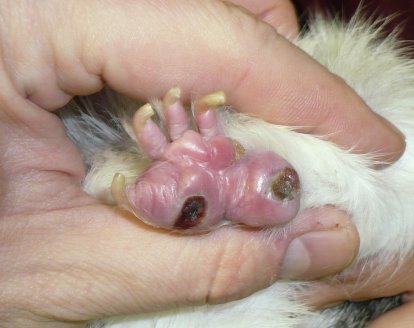
Bumblefoot
Bumblefoot is also known as Ulcerative pododermatitis, is an extremely painful infection of the footpad.
It most cases it can be avoided and is due to neglect for the pet. The footpad is swollen and may be crusted and/or bleeding. If the bone becomes infected, the leg may need to be surgically removed. Left untreated, bumblefoot can result in death.
Bumblefoot is often attributed to abrasions caused by wire floors or rough bedding which allow infections (typically Staphylococcus aureus, a common environmental bacteria) to become established. Poor sanitation, not cleaning the hutch often enough and wet bedding, is the most common cause of bumblefoot. Certain health conditions also are a factor such as heart conditions which cause a lack of activity and obesity may be factors.
Guinea pigs are one of many animals that can suffer from this disease. Rabbits can suffer from this condition too!
Photo from Wikipedia
Prevention is always better:
1. Keep their hutch or cage as dry as possible, Clean them out regularly and don’t them sit on wet floors. Look for damp patched daily and replace with dry. Increased bacteria can lead to more infection. Therefore, cleaning and disinfecting the cage more often can help decrease your guinea pig's chances of getting bumblefoot, as well as help with recovery if your pet already has the condition.
2. Create a smooth floor, No wire bases or rough floors.
3. Use softwood shavings, or paper-based bedding or fleeces.
Keep an eye on your Guinea Pigs feet. If they are starting to look red and swollen, get them checked out by a vet.
Treatment:
If you think your Guinea Pig or Rabbit has bumblefoot, a vet can diagnose the problem for you. Treatment is available to cure bumblefoot, but it is a slow and lengthy process often taking weeks to cure. Ask your vet about pain killers, foot soaks and foot rubs.
Trim the pig's nails. While you should be trimming the nails at least once a month anyway, doing so while the guinea pig has bumblefoot is especially important. Long nails can sometimes be a cause of bumblefoot.
Increase vitamin C. Sometimes, guinea pigs don't get enough vitamin C in their diet. In turn, their bodies won't produce enough collagen, which can increase problems with bumblefoot. Adding more vitamin C to the diet can help solve the problem
Put your guinea pig on a diet. Being overweight can cause or worsen bumblefoot. If your guinea pig is overweight, decrease its food a little bit. Reducing the calories your guinea pig eats should help it lose weight

